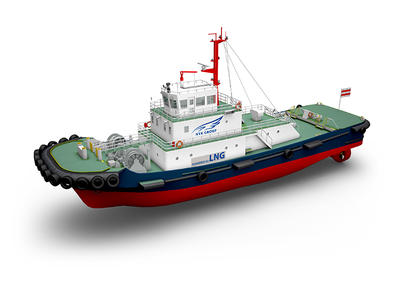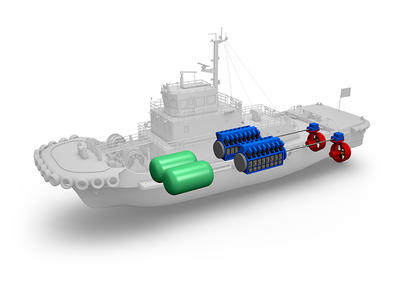NYK to Build Japan's First LNG-Fueled Tug
December 24, 2013

Image of LNG-fueled tugboat
NYK will build a tugboat1 featuring a dual fuel engine2 that can be powered by either liquefied natural gas (LNG) or heavy oil. Other than LNG carriers, this tugboat will be the first building in Japan of an LNG-fueled vessel.
NYK has enhanced its initiatives to mitigate environmental loads through the practical realization of environment-responsive technologies such as solar-powered systems and air-lubrication systems.3 In 2011, NYK established a team in the company’s Fuel Group to research next-generation fuel alternatives to heavy oil, and looked into building an LNG-fueled vessel with the cooperation of Nippon Kaiji Kyokai and others, based on the results of a survey conducted by the Japan Railway Construction, Transport and Technology Agency. LNG received attention as a possible alternative to heavy oil because LNG does not emit any SOX and produces far less CO2 and NOX compared to heavy oil. In fact, using LNG as a fuel will cut this tugboat’s emissions of CO2 by about 30%, NOX by about 80%, and SOX by 100% compared to using heavy oil.4

Image of main engine
This project will be subsidized by Japan’s Ministry of Economy, Trade and Industry and Japan’s Ministry of Land, Infrastructure, Transport and Tourism. Tokyo Gas Co. Ltd. (head office: Tokyo) will supply the LNG, and with the support of Tokyo Gas, NYK will make arrangements for a safe LNG supply system.
The NYK Group will aggressively continue to encourage initiatives to mitigate environmental loads by vessels.
1 Tugboat
A small boat that assists a large vessel leaving from and arriving at harbors and inland waterways.
2 Dual fuel engine
Engine that can use either liquefied natural gas (LNG) or heavy oil. If the engine is powered by gas, environmental loads will be reduced.
3 Air-lubrication system
Energy-saving technology that takes some of the main engine scavenging air (combustion air) from the main engine’s turbocharger and leads it to the vessel’s bottom to reduce the frictional resistance between the vessel’s bottom and the seawater.
4 The benefits of LNG as a fuel were examined through research conducted by NYK and the following organizations:
- Japan’s Ministry of Land, Infrastructure, Transport and Tourism
- Nippon Kaiji Kyokai and two other companies
- The Japan Railway Construction, Transport and Technology Agency (JRTT)
Reference:
Announcement on December 13, 2013, "NYK Group's Air-Lubrication System Recognized at 2013 Eco-Products Awards"
The news on this website is as of the date announced and may change without notice.

